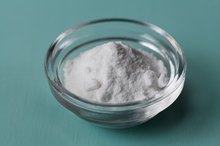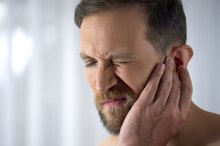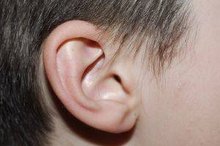How to Use Debrox Earwax Removal
At-home care is commonly used to remove the buildup of wax that impacts your ears, causing unpleasant symptoms such as earache or plugged-up ears, hearing loss, tinnitus, itching, odor and discharge. Debrox Drops, a nonprescription earwax removal aid, uses carbamide peroxide as its active ingredient 1. Carbamide peroxide, says the American Academy of Otolaryngology, is a detergent drop that softens earwax. Debrox Drops are approved by the U.S. Food & Drug Administration for use in people aged 12 and over. If treating someone under the age of 12, first consult with a physician.
If you are experiencing serious medical symptoms, seek emergency treatment immediately.
Apply five to 10 drops of Debrox Drops in the afflicted ear. According to the manufacturer, when the carbamide peroxide in this product makes contact with earwax, it releases oxygen, which creates a foam. You may hear crackling and popping sounds after using Debrox.
Baking Soda & Water for Ear Wax
Learn More
Use Debrox Drops two times a day for no longer than four days, or longer if your doctor advises prolonged use. This should sufficiently remove earwax, but if you still notice symptoms of impaction, proceed to Step 3.
Flush the ear with warm water. Irrigation can be performed at home using a bulb syringe or device manufactured for this purpose, says the AAO. Warm the water to body temperature first to prevent vertigo.
Tips
Irrigation works best if you use Debrox Drops 15 to 30 minutes before you irrigate the ear, says the AAO.
If you're unable to find Debrox Drops at your drugstore, the AAO states that mineral oil, baby oil, glycerin, hydrogen peroxide or other nonprescription drops can be used to soften earwax instead.
Warnings
Irrigating your ears is not advised if you have a perforated eardrum, have tubes placed in your ears, or if you have diabetes or a depressed immune system.
Related Articles
References
- Mayo Clinic: Earwax Blockage
- Schwartz S, Magit A, Rosenfeld R, et al. Clinical Practice Guideline (Update): Earwax (Cerumen Impaction). Otolaryngol Head Neck Surg. 2017;156(1_suppl):S1-S29. doi:10.1177/0194599816671491
- Cleveland Clinic. Swimmer's Ear (Otitis Externa). Updated January 29, 2019.
- Prokop-Prigge K, Mansfield C, Parker M, et al. Ethnic/Racial and Genetic Influences on Cerumen Odorant Profiles. J Chem Ecol. 2014;41(1):67-74. doi:10.1007/s10886-014-0533-y
- American Academy of Otolaryngology-Head and Neck Surgery. Clinical Practice Guideline: Cerumen Impaction. 2017.
- Zackaria M, Aymat A. Ear candling: a case report. Eur J Gen Pract. 2009;15(3):168-169. doi:10.3109/13814780903260756
- Burton MJ Ear drops for the removal of ear wax. Cochrane Database Syst Rev - 01-JAN-2009(1): CD004326
- Flint: Cummings Otolaryngology: Head & Neck Surgery, 5th ed.
- Lum CL. Antibacterial and antifungal properties of human cerumen. J Laryngol Otol - 01-APR-2009; 123(4): 375-8.
- Roland, Peter S. Clinical practice guideline: Cerumen impaction Original. Otolaryngology - Head and Neck Surgery, Volume 139, Issue 3, Supplement 2, September 2008, Pages S1-S21.
- Tomita, Hiroaki. Mapping of the wet/dry earwax locus to the pericentromeric region of chromosome 16. The Lancet. Volume 359, Issue 9322, 8 June 2002, Pages 2000-2002.
Writer Bio
Lisa Sefcik has been writing professionally since 1987. Her subject matter includes pet care, travel, consumer reviews, classical music and entertainment. She's worked as a policy analyst, news reporter and freelance writer/columnist for Cox Publications and numerous national print publications. Sefcik holds a paralegal certification as well as degrees in journalism and piano performance from the University of Texas at Austin.








